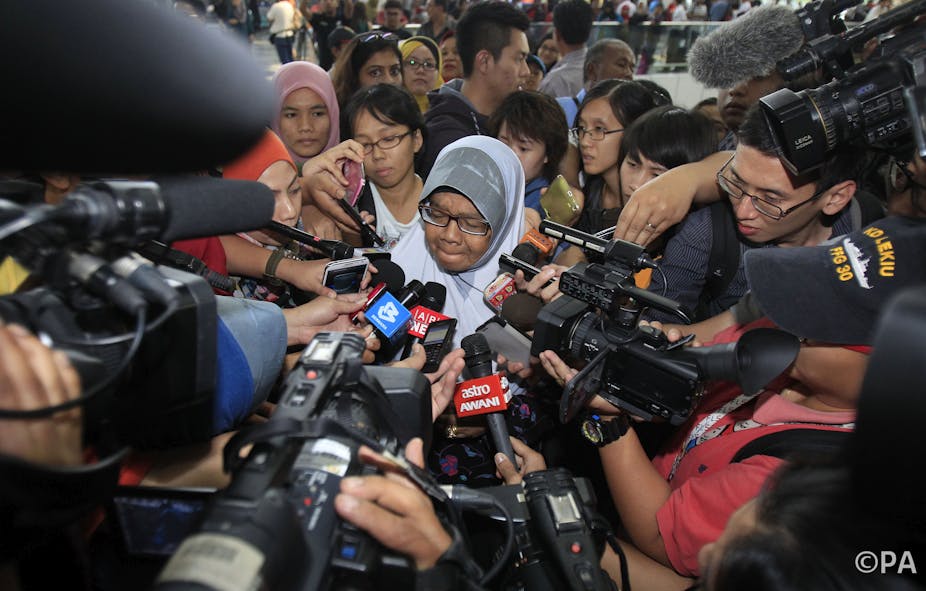The scenes in Kuala Lumpur are harrowing. While desperate relatives wait for news, seemingly callous reporters crowd around them, taking photographs, filming tears and thrusting microphones into their faces.
Both groups are caught up in the all-encompassing drama of missing airliner MH370 – but whereas one may face a truly life-changing loss, the other is doing a job. It is a chaotic, emotionally-devastating job, but it is important work, nonetheless.
What we have here are competing interests. Each has a claim to justifiable rights: relatives have the right to privacy and dignity while coming to terms with their grief and shock; journalists have the right to carry out their duty to tell the truth, to inform the public and to hold those in authority to account.
But this is not a black-and-white issue. Some relatives actively seek out the media, particularly when no-one in authority appears to be listening or keeping them informed. Some reporters shun their fellow journalists and unobtrusively do their job by respectfully approaching families.
Our research suggests that people who have experienced trauma are often eager to have their story heard. Most of the bereaved families we interviewed wanted journalists to understand that their story belongs to them, not to the journalist, and this may apply to the relatives of those on Flight MH370. Equally, the absence of reporting personal human tragedy might have as distressing an effect, leaving the traumatised feeling neglected and their pain unacknowledged. Sudden trauma makes people more vulnerable, but not necessarily incapable of making decisions for themselves.
In disasters, where little is known and even less is confirmed, finding the truth can be a difficult task. Therefore, TV crews gather all the footage they can to send back to their editors who decide what we view in our news bulletins. Because of the competitive nature of news, a media mob forms and inevitably cameras get thrust in the faces of over-whelmed relatives. Thus, journalists’ duty to the job takes over and ethical fundamentals like minimising harm to those in their stories can be compromised in order to capture the bereaved’s emotive reactions.
Prying or public interest?
But why does the media have to gather footage of people in emotional turmoil? Principally, because it is part of the tragedy, just as much as what happened to the plane or the authorities’ responses. There is a need to record the whole story and to resist sanitizing the news by avoiding human suffering. Portraying grief can be done with sensitivity and care. For example, some coverage has used humanising factors in a respectful manner. Shots at the airport say much without commentary; the young Malaysian woman with the baby at her hip; older women sitting in silence; a small child being comforted as she cries. Our research indicates that for families bereaved by trauma, the idea that something positive has come out of their suffering is at least some comfort for their loss.
Equally, there is a public interest justification for the full story to be recorded as it happens to bring those in authority to account later, to provide explanations for the grieving during the tragedy and afterwards and to help communities globally understand and share what has happened.
So how do journalists negotiate the boundary between intrusion and legitimate news-gathering; between using grief for ratings and allowing the relatives’ stories to be told? It is unlikely they will ever get it completely right. There are too many emotions and human variables in the mix for that.
Our research suggests two dominant approaches. First, journalists should pause to assess the potential harm they could cause by their reporting. Second, they should be as honest as possible with interviewees about what they want, what their report could achieve, and inform relatives that others are involved in editorial decisions about the story. This is much easier to achieve in small groups than in a media scrum, but in large-scale incidents the authorities can take some responsibility for the relatives’ well-being and dealings with the media. This happened to some extent with Flight MH370 but it seemed reactive rather than proactive.
It is also important to remember that relatives involved in a tragedy are often very aware of its harrowing details and therefore less squeamish about coverage than the public. The BBC acknowledges this in its editorial guidelines.
Few, if any, journalists covering the airliner’s disappearance will remain untouched by the pain of the families and friends. For many it will leave a lasting mark and as research sponsored by the Dart Center acknowledges, it will have consequences for the mental health of some. But outside the airport a whole world is waiting for news of Flight MH370 and it is the reporters’ job to provide that.

